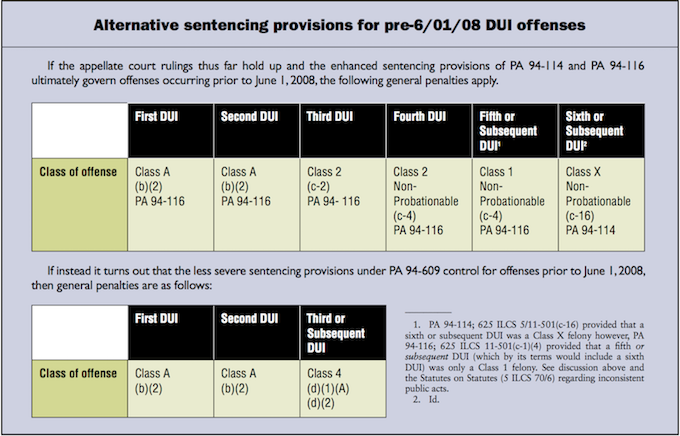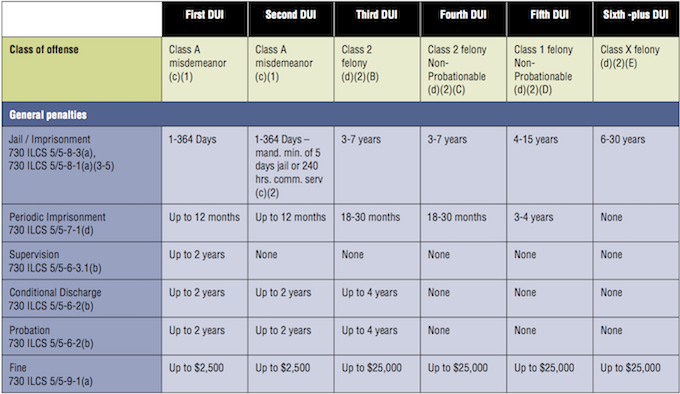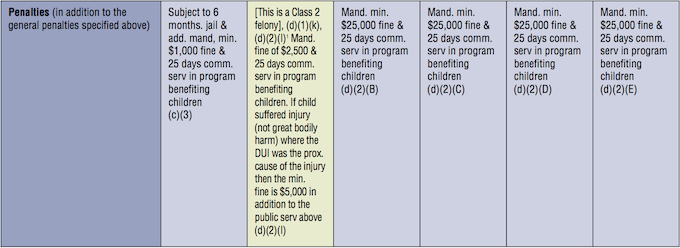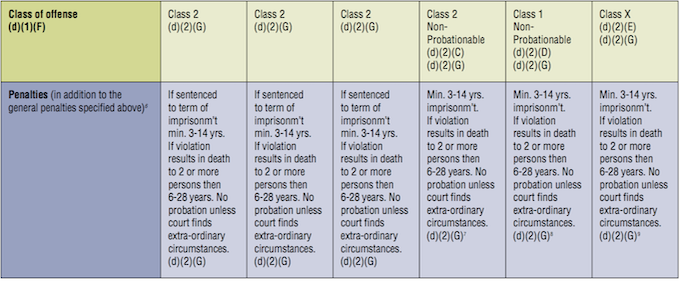Demystifying Illinois DUI Sentencing
In 2008, Illinois enacted legislation resolving DUI sentencing inconsistencies. This article translates the complex DUI sentencing provisions into chart form to help practitioners determine which penalties their DUI clients face. It also discusses continuing litigation created by the earlier inconsistent law.
Beginning with the passage of several public acts in the spring of 2005 and until June 1, 2008, lawyers advising clients with multiple DUI convictions were faced with a nearly impossible challenge. They had to sort through not one but six different and inconsistent versions of the DUI statute, drawn from eight different public acts.1
Thus, if your DUI2 client nervously informed you that he had twice been found guilty of DUI and asked what would happen if he were convicted a third time, your search of the Illinois Vehicle Code3 would have left you with no definitive answer. It was unclear whether he faced sentencing under felony guidelines or stricter provisions.4 This was the situation facing not only defense attorneys but prosecutors and judges as well.
Fortunately, a long awaited clarification of DUI sentencing laws arrived on June 1, 2008, in the form of PA 95-578.5 The chart accompanying this article (see pages ) organizes the myriad sentencing provisions, which are based on the number of offenses committed and specific enhancing factors, to help you determine the impact of the law on your client.
But what about defendants convicted under the old inconsistent acts, both those who have been sentenced and whose cases remain pending? Have they been, or will they be, properly sentenced? This article reviews the statues and cases and describes the sentencing rules that would apply if courts apply the stricter or, alternately, the more lenient approach.
What's the Correct Penalty Under the Previous Statutes for a Third or Subsequent DUI Offense?As is illustrated by the client query at the top of the article, probably the biggest question under the earlier inconsistent acts was which sentencing provisions applied to third or subsequent DUI offenders. Before the passage of those acts, a person convicted of a third or subsequent DUI violation was almost always guilty of a felony. Unless there were specified enhancing factors, the number of offenses beyond three was irrelevant; the offense was a probationable offense.6
But the enactment of enhanced DUI sentencing provisions contained in the 94th General Assembly’s passage of PA 94-114 and PA 94-116, and the subse-quent passage of three additional pub-lic acts amending the same DUI statute, made it hard to determine whether these third or subsequent offend-ers were guilty of a Class X, Class 1, Class 2, or Class 4 offense.
Analyzing the issues re-quires reviewing the acts and their dates of passage. PA 94-114 passed on May 11, 2005, provided that a sixth or subsequent offense was a Class X felony;7 PA 94-116 passed on May 16, 2005, pro-vided that a third offense was a Class 2 probationable felony,8 a fourth offense was a Class 2 non-probationable felony,9 and a fifth or subsequent offense was a Class 1 non-probationable felony.10
If that weren’t enough, the follow-ing three additional public acts amend-ing the DUI statute were passed by the 94th General Assembly after the en-hanced provisions of PA 94-114 and 94-116 were passed.
First, PA 94-329 passed on May 18, 2005, provided that a person who com-mitted a DUI offense and did not have a valid driver’s license or liability insur-ance was guilty of a felony.11 Second, PA 94-609 passed on May 20, 2005, pro-vided that a person could not get proba-tion where the DUI was the proximate cause of death unless the court found ex-traordinary circumstances.12 Third, PA 94-963 passed on April 25, 2006, estab-lished a DUI police officer education and training fund.13
Neither PA 94-329 nor PA 94-609 contained the enhanced sentencing pro-visions contained in the earlier-passed PA 94-114 and PA 94-116. Instead, the newer acts continued to generally pro-vide that a third or subsequent DUI con-stituted a Class 4 felony.14
The drafters of PA 94-963, apparently not certain which of the other seven ex-isting public acts controlled (including those passed by earlier General Assem-blies and not repealed), simply included its amendments in all seven acts and oth-erwise republished them in full.15
Statute on Statutes. Section 5 ILCS 70/6 of the Statute on Statutes provides guidance where there exist conflicts be-tween different public acts:
Two or more Acts which relate to same subject matter and which are enacted by the same General Assembly shall be con-strued together in such manner as to give full effect to each Act except in case of an irreconcilable conflict. In case of an irrec-oncilable conflict the Act last acted upon by the General Assembly is controlling to the extent of such conflict. The Act last acted upon is determined by reference to the final legislative action taken by either house of the General Assembly, whether such final action is passage on third read-ing in the second house, concurring in or receding from an amendment, adoption of a conference committee report, accep-tance of the Governor’s specific recom-mendations for change, or passage over the Governor’s veto. However, for the pur-pose of determining the effective date of laws under Section 10 of Article IV of the Constitution of 1970 and “An Act in re-lation to the effective date of laws”, ap-proved July 2, 1971, a bill is “passed” at the time of its final legislative action before presentation to the Governor as provided in paragraph (a) of Section 9 of Article IV of the Constitution of 1970.

An irreconcilable conflict between 2 or more Acts which amend the same section of an Act exists only if the amendatory Acts make inconsistent changes in the sec-tion as it theretofore existed.
The rules of construction provided for in this section are applicable to Acts enacted by the same General Assembly throughout the 2 year period of its exis-tence.16
All of the public acts at issue here were passed by the 94th General Assem-bly. On its face, the Statute on Statutes opens the door to the argument that PA 94-609, passed on May 20, 2008 and thus after PA 94-114 and PA 94-116, controlled sentencing law until June 1, 2008, when PA 95-578 was passed. (Be-cause PA 94-963 simply republished allof the earlier inconsistent public acts, its impact is discounted here). Thus, accord-ing to this logic, any third or subsequent DUI (absent aggravating factors) was a Class 4 felony regardless of the number of DUI violations in excess of two.17
However, courts that have ruled on the issue thus far have found against de-fendants, holding that the stricter Class 2 felony guidelines apply.
Appellate holdings. In People v Prouty,18 the defendant was convicted of DUI for a third or subsequent time and sentenced by the trial court under Class 2 felony guidelines as provided in PA 94-116. The trial court rejected the defen-dant’s claim that he should be sentenced under Class 4 felony guidelines provided under PA 94-609. After his motion to re-consider was denied, the defendant ap-pealed.
The second district appellate court re-viewed the legislative histories of both acts. The defendant argued that although PA 94-116, as passed on May 16, 2005, specifically added language that made the defendant’s offense a Class 2 felony, the passage of PA 94-609 four days later on May 20, 2005, effectively repealed the amendment in PA 94-116. PA 94-609 provided instead that the defendant’s of-fense was a Class 4 felony.
The court, citing People v Caraballo,19 noted the general rule that “when an act is amended so as to read as it is re-peated in the amendatory act, portions of the old law not repeated are deemed re-pealed.”20 However, the court also noted that Caraballo held that this rule had to be interpreted in light of the Statute on Statutes “as well as the imperatives of harmonizing legislative acts if reasonably possible and effectuating the legislature’s intent.”21
In holding that PA 94-609 did not re-peal the enhanced sentencing provisions of PA 94-116, the court began by citing this admonition in Dickey v Southern Ry Co:22 “if two acts may be construed to-gether so that both may stand, we must do so” and that the “ultimate goal is to effectuate the intent of the legislature.”
While agreeing that the acts did con-flict, the court held that they did not “ir-reconcilably conflict,”23 reasoning that (1) PA 94-609 did not explicitly repeal the amendments of PA 94-116, and (2) if the legislature had intended such a repeal it would have lined out the lan-guage added by PA 94-116 and restored the previous language. It did not do so, suggesting that the drafters of PA 94-609 “simply overlooked what had just been added by PA 94-116.”24
The court’s conclusion in Prouty has been cited with approval in two other ap-pellate decisions, People v Maldonado25 and People v Gonzalez.26 Maldonadodealt with PA 94-329, which was passed May 18, 2005, and provided that a DUI offense by an offender who did not pos-sess a valid driver’s license was a Class 4 felony instead of a Class A misdemeanor. The court ruled that PA 94-329 was not invalidated by the later passage of PA 94-609, which did not contain that enhance-ment. In Gonzalez, a consolidation of two cases, the court again held that the provisions of PA 94-329 were enforce-able despite the later passage of PA 94-609.
The appellate rulings suggest that courts will disregard facial inconsis-tencies among two or more public acts passed by the same General Assembly if the legislative purpose and the failure to explicitly repeal earlier language indicate that the later-passed act was not intended to overturn the former.
Under the Previous Statutes, is the Sixth or Subsequent DUI a Class 1 or Class X felony?There is also an inconsistency be-tween PA 94-114, which provides that a sixth or subsequent offense is a Class X felony, and PA 94-116. PA 94-116 was passed five days later and provides that an offender committing his or her fifth or subsequent offense was only guilty of a Class 1 felony.27
The reasoning employed in Prouty, Maldonado, and Gonzalez may not apply to this inconsistency. While PA 94-116 did not explicitly repeal the Class X language in PA 94-114, it did add spe-cific new sentencing language that made a fifth or subsequent offense a Class 1 fel-ony. This is distinguishable from PA 94-609, at issue in the Prouty line of cases, where the act simply republished the sen-tencing scheme as it existed prior to the enhancements contained in 94-114 and 94-116.
The two sentencing schemes for pre-June 1, 2008 offenses – one applicable if the enhanced provisions of PA 94-114 and 94-116 survive, the other if they are stricken – appear on page 354.
DUI Sentencing at a GlanceThe DUI statutes include a bewildering array of sentencing alternatives based on how many DUI offenses a defendant has committed and various enhancing factors. The following chart attempts to clarify, if not simplify, DUI sentencing options by starting with the basic offense classifications and penalties and following with the harsher penalties imposed for more serious offenses. All statutory subsection references are to 625 ILCS 5/11-501 unless otherwise noted. Also, see the public act for provisions governing restitution, lab analysis, victim impact panel, surcharges, emergency response, and evaluation/treatment.
Basic DUI Offense Classifications and Penalties
• DUI violation w/BAC of 0.16 or more

• DUI violation Involving Transport of Child Less Than Age 16

• DUI Violation while driving a school bus w/ person 18 yrs. or younger on board

• DUI violation when offendor was involved in m.v accident where DUI was the prox. cause of great bodily harm or disfigurement to another

• 2nd DUI vio. w/ prior conviction for reckless homicide while DUI or a prior conviction under (d)(1)(C) or (d)(1)(F)

• DUI violation in school speed zone & inv in an acc’d w/ bodily harm –other than great bodily harm, perm. disability or disfigurement where DUI is prox. cause

• for DUI violation w/ death in a motor vehicle, snowmobile, watercraft or all-terrain vehicle where DUI is prox. cause

* Note that all offendors sentenced under section 11-501(d)(1) who are placed on conditional discharge or probation must serve a minimum term of either 480 hours of community service or 10 days imprisonment as a condition of condition discharge or probation, in additional to any other penalties. See 625 ILCS 5/11-501(d)(3). Also see vehicle seizure and forfeiture provisions of 720 ILCS 5/36-1.
• DUI violation that occurs during period of revocation, suspension for prior DUI, statutory sum. suspension, leaving the scene of a death of personal injury or reckless homicide

• DUI violation that occurs while the person did not have a valid driver’s license or permit

• DUI violation that occurs while the person did not have liability insurance

• DUI violation involving an accident while transporting a child under the age of 16 resulting in bodily harm to the child (other than great bodily harm)

1. See Public Acts 93-1093, 94-110, 94-113, 94-114, 94-116, 94-329, 94-609 and 94-963. It is unclear how this problem arose and was allowed to continue over several years. Typically, major inconsistencies in proposed bills are detected by the Illinois Legislative Reference Bureau, which is charged with reviewing legislative proposals and putting them into bill form prior to filing. Any remaining errors or inconsistencies are usually resolved as they move through the legislative process or, in the end, by the governor’s staff before signing. Here, the system failed.
2.625 ILCS 5/11-501.
3.625 ILCS 5/1-101 et seq.
4.Class 4 offenses carry a potential 1 to 3 years in the penitentiary pursuant to 730 ILCS 5/5-8-1(a)(7); Class 2 offenses carry a potential 3 to 7 years in the penitentiary pursuant to 730 ILCS 5/5-8-1(a)(5).
5.PA 95-578 (eff 6/1/08 except certain parts addressing statutory suspensions and monitored device driving permits eff 1/1/09).
6.See 625 ILCS 5/11-501(d)(2)(2005).
7.PA 94-114; 625 ILCS 5/11-501(c-16).
8.PA 94-116; 625 ILCS 5/11-501(c-1)(2).
9.PA 94-116; 625 ILCS 5/11-501(c-1)(3).
10.PA 94-116; 625 ILCS 5/11-501(c-1)(4).
11.PA 94-329; 625 ILCS 5/11-501(d)(1)(G) and (H).
12.PA 94-609; 625 ILCS 5/11-501(d)(2).
13.PA 94-963; 625 ILCS 5/11-501(j) and (k).
14.PA 94-329 and PA 94-609; 625 ILCS 5/11-501(d)(2).
15.See all versions of 625 ILCS 5/11-501(j) as contained in PA 94-963.
16.5 ILCS 70/6.
17.PA 94-609; 625 ILCS 5/11-501(d)(2).
18.385 Ill App 3d 149, 895 NE2d 48 (2d D 2008), appeal denied, 231 NE2d 647, 902 NE2d 1088 (Table 2009).
19.231 Ill App 3d 685, 596 NE2d 1322 (2d D1992).
20.Prouty at 154, 895 NE2d at 52.
21.Id at 155, 895 NE2d at 52.
22.17 Ill 2d 550, 162 NE2d 417 (1959).
23.Prouty at 154, 895 NE2d at 51.
24.Id at 154, 895 NE2d at 52.
25.386 Ill App 3d 964, 897 NE2d 854 (2d D 2008), appeal denied,231 Ill 2d 645, 902 NE2d 1088.
26.2009 WL 839964 (3d D 2009).
27.PA 94-114; 625 ILCS 5/11-501(c-16) and PA 91-116
1. 625 ILCS 5/11-501(d)(2)(I) provides that a violation of 625 ILCS 5/11-501(d)(1)(K) (2d DUI that occurs while transporting a child under the age of 16) is a Class 2 felony; 625 ILCS 5/11-501(d)(2)(A), on the other hand, provides that a violation of 625 ILCS 5/11-501(d)(1)(J) (the same offense which in addition results in bodily harm to the child (other than great bodily harm)) is only a Class 4 felony. If a court were to find that these provisions violate the proportional penalties clause of the Illinois Constitution, defendants convicted under them would be sentenced under Class 4 guidelines. See Ill Const 1970, Art I, §11 and the Illinois Supreme court’s recent decision in People v Klepper, 2009 WL 711126.
2. 625 ILCS 5/11-501(d)(2)(F) states that a defendant who receives a prison term for this offense shall be sentenced to not less than one nor more than 12 years. However, the penalty for the offense ranges from Class 4 (1-3 years), Class 2 (3-7 years), Class 1 (4-15 years), and Class X (6-30 years), depending on the number of prior offenses, if any. If a court finds these provisions to be conflicting or ambiguous, the rule of lenity would appear to require that defendants be sentenced to a minimum of one year to a maximum of the highest sentence provided for by the class of the offense or 12 years, whichever was lower. Thus, the penalty range would be as follows: for a Class 4 offense, 1-3 years; for a Class 2 offense, 1-7 years; for a Class 1 offense, 1-12 years; and for a Class X offense, 1-12 years. See People v Perry, 224 Ill 2d 312, 864 NE2d 196 (2007).
3. 625 ILCS 5/11-501(d)(2)(F) provides for a sentencing range of 1-12 years only if the defendant is sentenced to a term of imprisonment. However, since this offense is nonprobationable, a sentence of imprisonment would appear to be mandatory.
4. Id.
5. Id.
6. 625 ILCS 5/11-501(d)(2)(G) states that a violation of 625 ILCS 5/11-501(d)(1)(F) is a Class 2 felony, regardless how many prior DUI offenses the defendant may have. It further states that an offender may be sentenced to a prison term of not less than three nor more than 14 years for a single death, unless the court finds that extraordinary circumstances make the offense probationable. However, the sentencing range is 3-7 years for a Class 2 offense, 4-15 years for a Class 1 offense, and 6-30 years for a Class X offense. If these provisions were determined to be in direct conflict or ambiguous, the rule of lenity would appear to require that defendants sentenced to prison must fall within a range of a minimum of three years to a maximum of 14 years or the sentencing range provided for by the class of the offense or 14 years (for a single death), whichever was lower. Accordingly, the sentencing range for a Class 2 offense would be limited to 3-7 years; a Class 1 offense, 3-14 years; and a Class X offense, 3-14 years. See Perry, cited in note 2.
7. 625 ILCS 5/11-501(d)(2)(G) makes this offense nonprobationable unless the court finds extraordinary circumstances. However, based on the number of prior DUI offenses, this offense is nonprobationable. If these provisions were determined to be in direct conflict or ambiguous, the rule of lenity would appear to require that defendants be probation eligible. See Perry, cited in note 2.
8. Id.
9. Id.
10. The mandatory fine of $2,500 and 25 days of community service in a program benefiting children provided for under 625 ILCS 5/11-501(d)(2)(H) for violations of 625 ILCS 5/11-501(d)(1)(J) is in addition to any other sanction. Since 625 ILCS 5/11-501(d)(2)(B-E) provides for an additional fine of $25,000 and 25 days of community service in a program benefiting children for an offense containing the same elements – beginning with the third DUI – it is unclear whether these penalties for third and subsequent DUIs are cumulative.
This article is also available as the original PDF document.
 Illinois Complex DUI Defense Lawyer The Davis Law Group, P.C. Home
Illinois Complex DUI Defense Lawyer The Davis Law Group, P.C. Home











